�
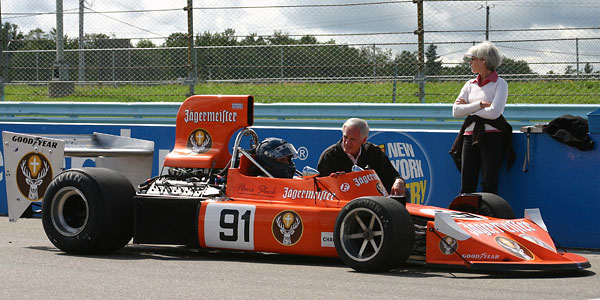
�
�
Steve Cook's March 741 (1974 Formula One) Historic Grand Prix Car
� by: Curtis Jacobson�� � Owner: Steve Cook
� City: Yountville, California
� Chassis: March 741 serial number 1
� Engine: Ford Cosworth DFV 3.0L V8
� Race prepared by: Steve Cook and Doug Peterson �
� �
Background: March Survived a Disastrous 1973 F1 Season
��
Ronnie Peterson placed second overall in the 1971 Formula One World Championship. Despite being�
consistently quick, he spent most of his season chasing Jackie Stewart's Tyrrell.�
In 1971's eleven races, Peterson never managed to qualify quickest or finish first.�
Hungrier and hungrier for victory, the 1972 season brought Peterson increased frustration and�
disappointment. In this second season at the March F1 team, Peterson sank to ninth place in �
championship points. Colin Chapman of the Lotus F1 team came along and offered a contract. In�
August 1972, March Engineering directors Robin Herd and Max Mosley learned Peterson would be�
moving on. �
�
March's reaction was to begin courting Chris Amon for a proposed one-car F1 effort. It seemed�
a contract was certain until late December, but Amon wouldn't be signed without any retainer�
whatsoever. March F1 Team Manager Pete Kerr explained the fallout of failed negotiations�
to Autocourse editor Alan Henry: "From that moment on, the F1 team was completely ignored�
by Max and Robin who were concentrating their efforts on the BMW-supported F2 program."�
�
That's the better known side of the coin. I asked Robin Herd to preview a rough draft of this�
article and he provided me with a little bit of the back-story: "Max was the F1 race engineer for�
1972/73/74 because by contract I had to devote my time to BMW. People laugh at the idea of Max�
being the F1 engineer, but as ever they do not know. He was better than numerous well known�
'professional' race engineers that I could mention." �
�
Nevertheless, development over the winter months seemed unambitious. In April, March publicly�
displayed their "new" 731 racecar, but anyone who looked very close could discern it was Niki Lauda's�
721G (serial number 4) with deformable structure added down the sides to comply with new rules�
applicable from the first race of the 1973 European season. Forward facing braces supplemented�
the roll hoop. Narrower front and rear track would make the car faster on straightaways. Denis�
Jenkinson of Motor Sport magazine reported that two additional March 731 cars were assembled:�
"both virtually new, but constructed from 1972 parts, either used or unused, depending on whether�
they originated from the workshop floor, under the bench or from the stores." �
�
Robin explained: "Sadly, March's F1 program was for its eight years always limited in a�
draconian manner by a congenital inability to get F1 sponsorship. Our main racing was inevitably�
the European F2 Championship using BMW's money... We should not really have taken part in F1, but�
that was where I started my motor racing life (at age 25!) as McLaren's first F1 designer, and we�
all loved F1."�
�
To fill the 731's seat, March F1 looked to their F2 team and specifically to French�
driver Jean-Pierre Jarier. Jarier would prove to be an excellent driver by delivering March-BMW the�
1973 European Formula Two Championship. Unfortunately, he didn't prove anything in F1.�
Jarier entered ten of fifteen 1973 Formula One World Championship rounds, yet scored just one�
eleventh-place finish. Henri Pescarolo had better luck. Brought in as a substitute driver for the�
Spanish Grand Prix, Pescarolo managed an eighth place finish. Another substitute driver, Roger�
Williamson might have brought March even greater success but his life ended horrifically during�
the Dutch Grand Prix. A tire failed, a fuel cell ripped open, and fire marshals stood by as flames�
grew around his overturned car. �
�
Despite all the setbacks, March's 1973 season ended on a hopeful note. Driving for Hesketh Racing,�
James Hunt used a Harvey Postlethwaite prepared March 721G to dog Ronnie Peterson all the way around�
Watkins Glen, lap after lap. One of F1's most memorable races came down to just 0.668 seconds.�
After that, there was no question of March dropping out of F1. With a little development and�
with the right driver, March could expect better results in 1974. �
�
 �
�
�
�
March's New Model for 1974
��
Although it featured a new aluminum monocoque tub, March's Formula One chassis for 1974 was really�
quite similar to its predecessor. In fact, all March F1 cars from the 721G model through the 771�
were essentially developments of the 712M chassis with which Ronnie Peterson had won the 1971 European�
Formula Two Championship. Development was almost entirely driven by the F2 program, and F1 designs�
were updated to keep current. However, greater fuel load requirements kept some aspects of the F1�
cars on a different path.�
�
�
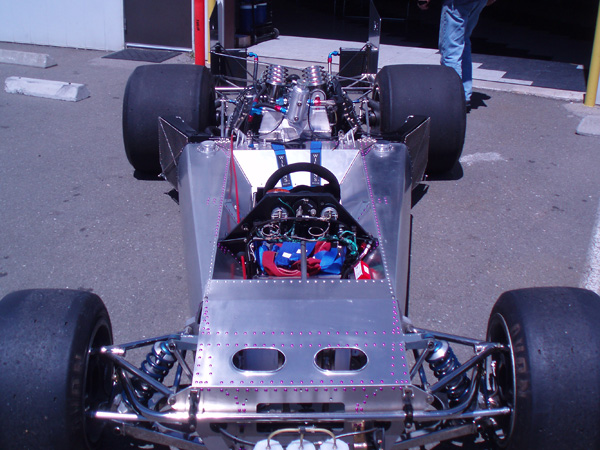
�
March 741 aluminum tub: wide at the engine bulkhead and tapering inward through the cockpit area.
�
(Photo by Steve Cook. Used here by exclusive permission.)
�
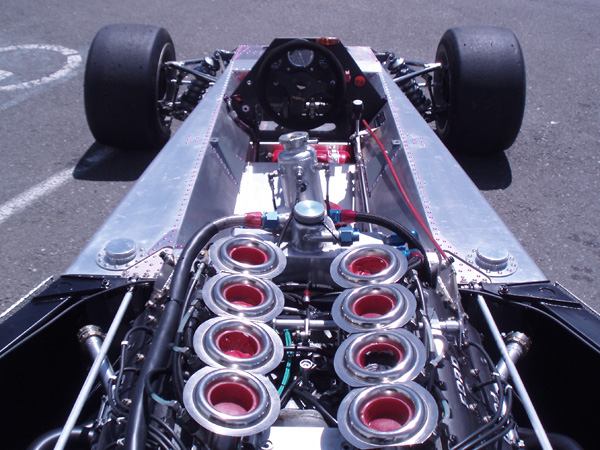
�
Although you can't see it well in this view, a single sandcast aluminum rear bulkhead carries engine
�
mounts, roll hoop mounts, shoulder belt attachment points, and both upper and lower trailing
�
link attachments. (Photo by Steve Cook. Used here by exclusive permission.)
�
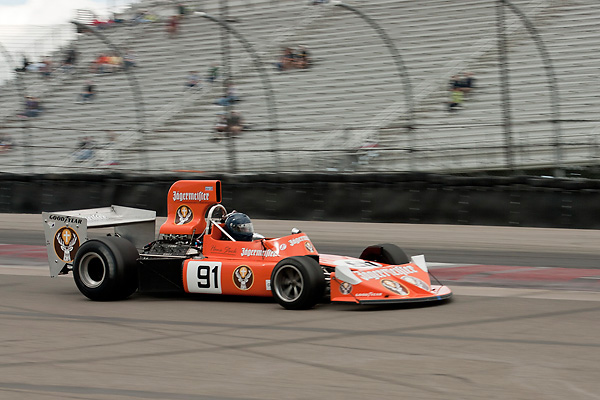
�
March 741 bodywork evolved from race to race. One constant was the car's full-width unducted
�
sportscar nose. Dual radiators were mounted forward of the rear tires, without any bodywork
�
around them. Up above, three very different airbox shapes were tried during the 1974 season.
�
�
Eighteen of the twenty constructors whose cars contested the 1974 Formula One Championship�
built up their cars around Cosworth's mighty DFV V8 engine. (The only exceptions were Ferrari�
and BRM.) March mated the 741's Cosworth engine to a Hewland FG400 transaxle.¹ �
�
March's F1 and F2 cars were designed to be simple, robust, and easily tunable. Wishbones and�
outboard mounted coilover shock absorbers were employed both front and rear. At the rear,�
single top links and parallel lower links were paired with twin radius arms to comprise de facto�
wishbones. Brakes were mounted outboard at the front and inboard at the rear. (More exotic�
configurations were utilized by higher budget teams. Examples:�
McLaren's M23 model�
used a pull-rod front suspension configuration to achieve a rising wheel rate. Lotus' 72 and�
76 models used inboard-mounted front brakes to reduce unsprung weight.) �
�
One of the most distinctive features of the 741 was its rear wing, which featured uncommonly�
large side plates. The wing itself wasn't particularly large: F1 wings through�
this era were restricted to 1100mm wide. From 1974, rear axle overhang was limited to 1000mm. �
�
With budgets perpetually tight, the ability of respective drivers to attract sponsorship factored�
heavily on seat assignments. Robin explains: "Howden Ganley was our choice of driver, as Max and�
I had to pay for it out of our own pocket! And he was a bloody good driver - not universally�
recognised by the outside world. The lack of detail build time soon showed up, but Howden went well,�
as expected. After two races, and in no part due to promise shown in those two races, sponsorship and�
another driver arrived. (It was Howden who introduced me to Bruce when I was working on Concorde�
at Farnborough, so he started the whole McLaren, March, et cetera, adventure. I guess this is�
responsible for my mild bias towards him ever since!)"�
�
Italian driver Vittorio Brambilla had persuaded an Italian manufacturer of professional grade handtools�
named Beta Utensili SPA to extend their sponsorship from F2 to F1. Brambilla retained this�
sponsorship and his seat on the March F1 team through the 1976 season. �
�
German driver Hans-Joachim Stuck brought digestif formulator Jägermeister in as an F1 sponsor,�
but just for the German Grand Prix. They had already agreed to sponsor his entire F2 season.�
Stuck raced without sponsor livery through the balance of the F1 year: he started the 1974 season�
with plain green paint and ended with plain orange.�
�
March only built two cars for the 1974 season, but due to shunts both cars had to be rebuilt on�
multiple occasions. By the end of the season, Stuck's March 741 had been rebuilt on new�
tubs twice and Brambilla's car had been rebuilt on new tubs three times.²�
At the time, March didn't retire serial numbers nor issue new numbers for extensively rebuilt cars. �
�
�
Please support the sponsoring companies who make www.BritishRaceCar.com possible, including:
� �
 �
�
�
�
March 741 Formula One Championship Series Results (1974-5)
�| Race | Date | Chassis #741-1 (three different tubs) | Chassis #741-2 (four different tubs) | |
| 1 | Argentine GP | Jan 13 | (1) Hans-Joachim Stuck Q23 Ret (transmission) | (1) Howden Ganley Q19 8 (fuel) |
| 2 | Brazilian GP | Jan 27 | (1) Hans-Joachim Stuck Q13 Ret (driveshaft) | (1) Howden Ganley Q20 Ret (ignition) |
| 3 | S. African GP | Mar 30 | (1) Hans-Joachim Stuck Q7 F5 | (1) Vittorio Brambilla Q19 F10 |
| 4 | Spanish GP | Apr 28 | (1) Hans-Joachim Stuck Q13 F4 (puncture) | (1) Vittorio Brambilla DNQ (shunt in practice) |
| 5 | Belgian GP | May 12 | (1) Hans-Joachim Stuck Q10 Ret (clutch) | (2) Vittorio Brambilla Q31 F9 |
| 6 | Monaco GP | May 26 | (1) Hans-Joachim Stuck Q9 Ret (shunt) | (2) Vittorio Brambilla Q15 Ret (shunt) |
| 7 | Swedish GP | June 9 | (2) Reine Wisell Q16 Ret (suspension) | (2) Vittorio Brambilla Q17 F10 (engine) |
| 8 | Dutch GP | June 23 | (2) Hans-Joachim Stuck Q22 Ret (shunt) | (2) Vittorio Brambilla Q15 F10 |
| 9 | French GP | July 7 | (2) Stuck DNQ / Brambilla F11 | (2) Brambilla Q16 (shunt after qualifying) |
| 10 | British GP | July 20 | (2) Hans-Joachim Stuck Q9 Ret (shunt) | (3) Vittorio Brambilla Q16 Ret (fuel system) |
| 11 | German GP | Aug 4 | (3) Hans-Joachim Stuck Q20 F7 | (3) Vittorio Brambilla Q23 F13 |
| 12 | Austrian GP | Aug 18 | (3) Hans-Joachim Stuck Q15 F11 (suspension) | (3) Vittorio Brambilla Q20 F6 |
| 13 | Italian GP | Sept 8 | (3) Hans-Joachim Stuck Q18 Ret (chassis) | (3) Vittorio Brambilla Q13 Ret (shunt) |
| 14 | Canadian GP | Sept 22 | (3) Hans-Joachim Stuck Q23 Ret (fuel system) | (4) Vittorio Brambilla DNQ |
| 15 | U.S. GP | Oct 6 | (3) Hans-Joachim Stuck DNQ | (4) Vittorio Brambilla Q25 Ret (fuel system) |
| 1974 Season results: | Hans-Joachim Stuck 16th (5 points) | Vittorio Brambilla 18th (1 point) | ||
| 1 | Argentine GP | Jan 12 | N.A. | (4) Vittorio Brambilla Q12 9 |
| 2 | Brazilian GP | Jan 26 | N.A. | (4) Vittorio Brambilla Q17 Ret (engine) |
| 3 | S. African GP | Mar 1 | N.A. | (4) Lella Lombardi Q26 Ret (fuel pressure) |
�
Note: driving for the Hesketh team, James Hunt drove a March in the first two rounds of�
the 1974 championship season. He retired early at Argentina but finished 9th in�
the Brazilian Grand Prix. He had previously driven the same car, chassis number�
721G/3, in the final seven rounds of the 1973 season. A 721G resembles a 722�
from nose to rear bulkhead, but resembles a 721 from engine bulkhead rearward.�
Six of the twelve March 721s featured this hybrid design.�
�
Please support the sponsoring companies who make www.BritishRaceCar.com possible, including:
� �
 �
�
�
�
�
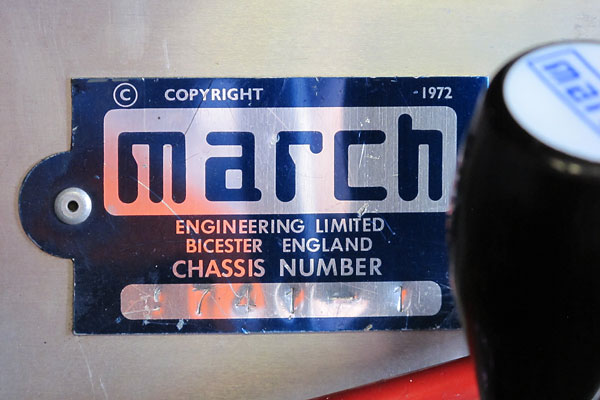
�
MARCH Engineering Limited, Bicester England - copyright 1972
�
Chassis Number 741-1
�
Provenance of Steve Cook's March Racecar (chassis 741-1)
��
�
Steve Cook's March 741 is unique: it's the only one with an FIA Heritage Certificate.�
The provenance of Steve's 741 is very well documented from when March raced it right up to�
today. Although it has been restored with many new components, it has always cast a shadow�
as March 741 serial number 1. Furthermore, its Heritage Certificate was signed by Max Mosley�
himself.�
�
Steve's 741-1 was purchased from March Engineering in 1976 by the baronet Sir Nicholas Frederick�
Hedworth Williamson for use in RAC hill climb events. He used it to win the 1976 Bouley Bay�
Hill Climb.�
�
Roy Lane, who had previously won the 1975 and 1976 British Hill Climb Championships with a modified�
McRae GM1 Formula 5000 racecar�
helped Williamson arrange the purchase and traveled with him to pick up the car. In November 1976,�
Lane purchased March 741-1 from Williamson.�
Lane modified 741-1 and used it in the RAC Hill Climb series through the 1977 and 1978 seasons.�
(After that, Lane owned and raced March 771 serial number 1.) Before he passed away in 2009,�
Lane had the opportunity to inspect Steve's car and positively confirm its identity as the one�
he bought and raced.�
�
In 1979 Lane sold 741-1 to Simon Riley of London who entered it in the 1979 British Sprint Series. �
Riley achieved one outright victory with 741-1. In August 1981 the car was sold to David Render.�
Render used it as a back-up car and with it he scored valuable points toward his 1983�
British Sprint Series championship victory.�
�
When Steve bought his 741-1, it was in rough shape. The car's original monocoque tub�
was straight but tired. Steve has had the tub partially rebuilt. The original bulkheads, fabricated�
steel braces, and outer panels were all left alone. An engine and transaxle were included with the�
sale, but the engine had been converted to short stroke / big bore configuration for hillclimb�
events, so it needed to be rebuilt to original specification to comply with vintage racing rules.�
The original March magnesium uprights were all okay and are still in use. All of the car's original�
fiberglass bodywork was gone, so new bodywork needed to be fabricated from scratch. A single,�
front-mounted radiator had been installed instead of the original side-mounted radiators. A�
March 761 center-post rear wing had been installed. �
�
Steve purchased copies of March's original engineering drawings from the "Marchives" and used them�
to make replacement front control arms, a new roll hoop, new rear suspension links, an accurate�
duplicate of the original rear wing, new rear wing mounts with some modifications for safety (see below),�
various cooling system components, etc.�
�
Steve completed the restoration of his March 741 in 2008. �
�
Since restoration, Steve has entered his March 741 in about four vintage race events per year.�
In 2012, he decided to travel east to try Lime Rock and Watkins Glen. Steve reports that Lime Rock was�
immensely enjoyable. The Historic Grand Prix cars had a great race there: "If you were really racing�
hammer and tongs it would be dangerous, but for a vintage race it was great fun." He also particularly�
enjoyed Watkins Glen, but for different reasons. His car seemed to be in its natural element: "It's as�
close to a European track as you're going to find here. You really feel like you're going somewhere."�
Yeah. In a hurry!�
�
�
�
IMPORTANT ANNOUNCEMENT
�
BritishRaceCar.com will have to cut back plans for continued growth if we can't find more financial support.
�
If you like what you've found here, and you want to see more, please click here and follow the instructions.
�
Readers like you keep BritishRaceCar.com online and growing through voluntary financial contributions.
�
Features and Specifications (as currently presented)
�| Engine: | �Ford Cosworth DFV V8 serial# 233, most recently rebuilt by Phil Reilly in California.�
(2993cc. 3.373" bore x 2.555" stroke. ~11.0:1 static compression ratio. Rated 480 HP at 10,500 RPM.)�
New crankshaft.�
New cylinder liners.�
New pistons and connecting rods.�
Rebuilt cylinder heads.�
New valve guides and seats.�
New valves, springs, and springs retainers.�
New camshafts.�
Lucas mechanical fuel injection.�
Lucas Capacitor Discharge Ignition System. | �
| Cooling: | �dual C&R side-mounted radiators.�
Dual Setrab 50-625-7612 25-row aluminum oil coolers. | �
| Exhaust: | �custom 4-into-1 headers. | �
| Transaxle: | �Hewland FG400 5-speed.�
Salisbury limited slip differential.�
AP 7.25" twin-plate clutch.�
CV-jointed halfshafts. | �
| Front Susp.: | �dual wishbone front suspension.�
March magnesium front uprights.�
Coilover KONI model 8212 double adjustable shock absorbers.�
Eibach springs.�
Adjustable (7-position) tubular anti-sway bar.�
5/32" toe-out. | �
| Rear Susp.: | �single top links, parallel lower links, and twin radius arms.�
March magnesium rear uprights.�
Coilover KONI model 8212 double adjustable shock absorbers.�
Hypercoil springs.�
Helper springs.�
Adjustable tubular anti-sway bar.�
1/16" toe-in. | �
| Brakes: | �(master) dual AP Racing master cylinders with plastic reservoirs. Adjustable bias bar. � (front) Lockheed CP2361 4-pot aluminum calipers and outboard-mounted vented rotors. � (rear) Lockheed CP2361 4-pot aluminum calipers and inboard-mounted vented rotors. | �
| Wheels/Tires: | �reproduction March magnesium racing wheels.�
Avon racing tires (10.0/20.0/13 front by 15.0/26.0/13 rear). | �
| Instruments: | �(left to right)�
Smiths dual oil pressure (0-160psi) and oil temperature (30-120C) gauge,�
Smiths tachometer (0-12500rpm) with tattletale, and�
Smiths dual fuel pressure (0-160psi) and water temperature (30-120C) gauge. | �
| Electrical: | �Odyssey Extreme Racing 30 AGM battery.�
Lucas alternator. | �
| Safety Eqmt: | �Willans six-point cam-lock safety harness.�
SPA Design quick release steering wheel hub.�
? centralized fire suppression system. | �
| Dimensions: | �58" front track.�
58" rear track.�
98" wheelbase. � � 1297 pounds (~588kg) with driver and ~5 gallons of fuel.� Approximately 36:64 weight distribution. � 235# front left, 230# front right, 415# rear left, 417# rear right. | �
Engine Installation
��
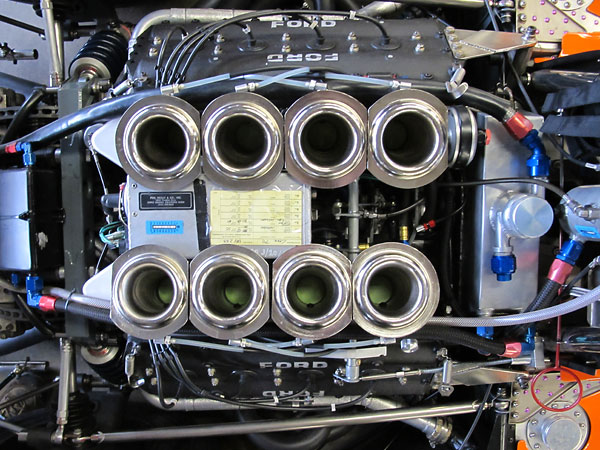
�
Ford Cosworth DFV V8 serial# 233, most recently rebuilt by Phil Reilly in California.
�
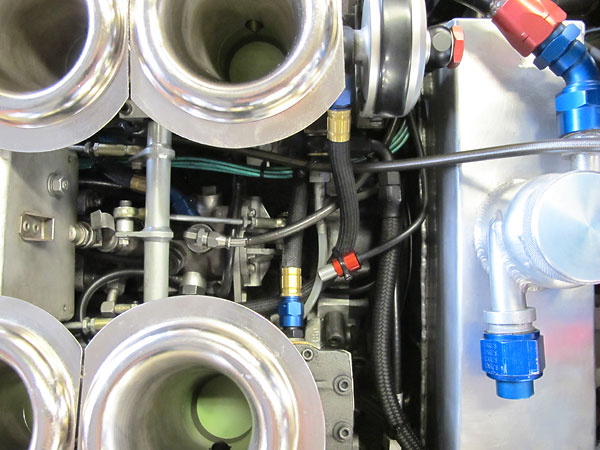
�
The Cosworth DFV's Lucas fuel metering unit is centered in the vee of the engine. The cylindrical
�
item at upper right in this view is the second of two fuel filters plumbed in series. Another
�
fuel filter is mounted beneath the driver's backrest, with the electric fuel pump that's used
�
exclusively for starting up the engine.
�
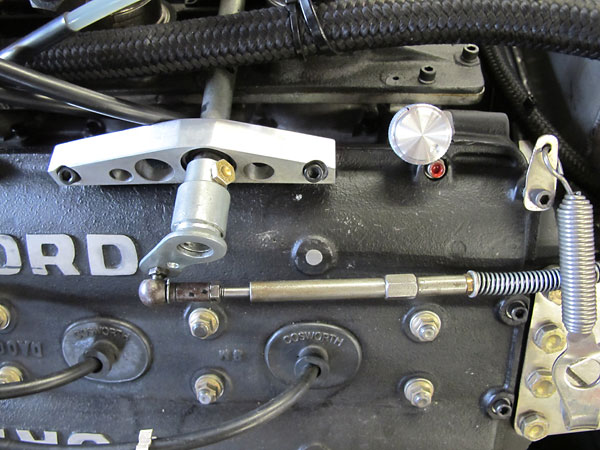
�
Throttle cable and linkage details. The aluminum knob at upper right is for selecting fuel
�
mixture. It's connected via rod to the mixture cam of the Lucas fuel injection metering unit.
�
(The engine doesn't have a choke.) Press the knob and set it all the way to the richest of
�
five positions until engine oil reachs ~50°C, then turn it to an intermediate position to finish
�
warming up. When it's turned to its racing position, the engine's idle will be very rough.
�
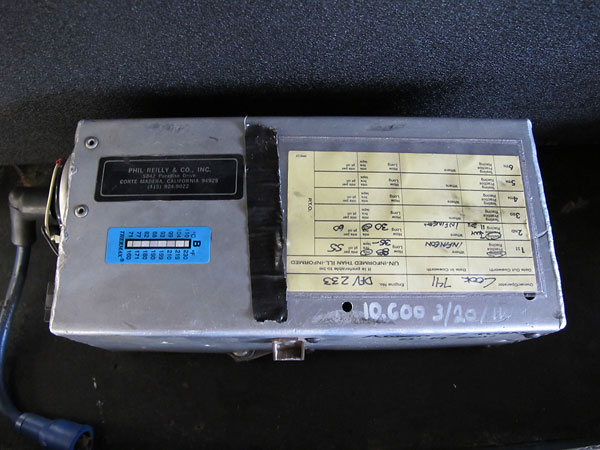
�
Temporarily removed for inspection: an early Lucas ignition box. (Note fabricated enclosure.)
�
Black: "Phil Reilly & Co., Inc., 5842 Paradise Drive, Corte Madera, California 94925, (415) 924-9022"
�
Blue: Thermax irreversible temperature indicator sticker. Beige: engine service note card.
�
White: "10,600 / 3/20/2011" appears next to the rev-limiter adjustment set screw.
�
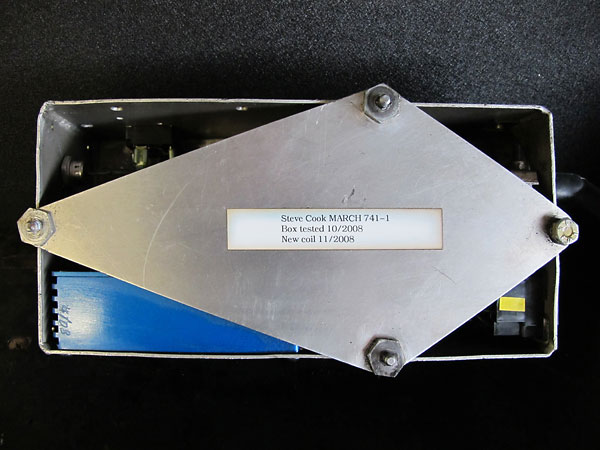
�
Steve Cook MARCH 741-1 - Box tested 10/2008 / New coil 11/2008
�
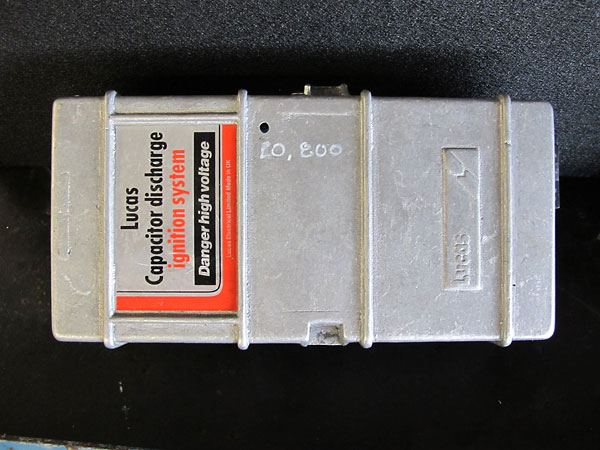
�
Steve carries this later model Lucas ignition box as a spare. (Note cast enclosure.)
�
Decal: "Lucas Capacitor Discharge Ignition System
�
Danger High Voltage - Lucas Electrical Limited, Made in UK"
�
White: "10,800" appears next to the rev-limiter adjustment set screw.
�
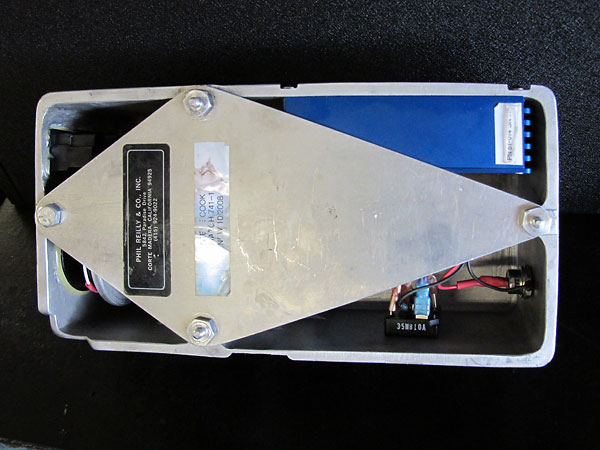
�
Cosworth DFV engines have a small dynamo mounted between their fuel metering unit and their
�
distributor. A Zener diode inside the ignition box (lower righthand corner of this photo) is used
�
as a voltage regulator. Note: blue anodized electronic spark box (at upper right) is a modern
�
component which enhances reliability. Most Historic Grand Prix cars are similarly equipped.
�
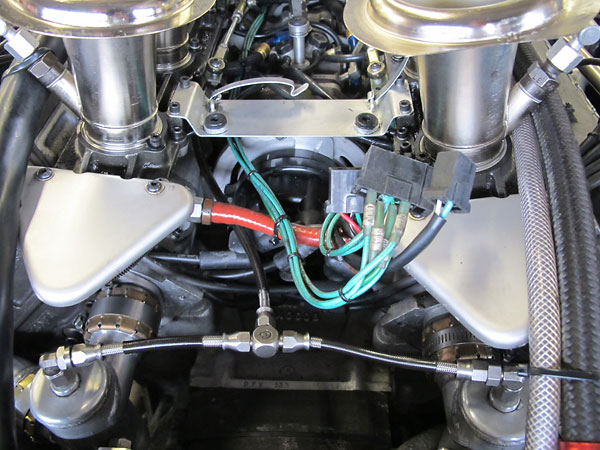
�
Green braided wire insulation is an authentic detail.
�
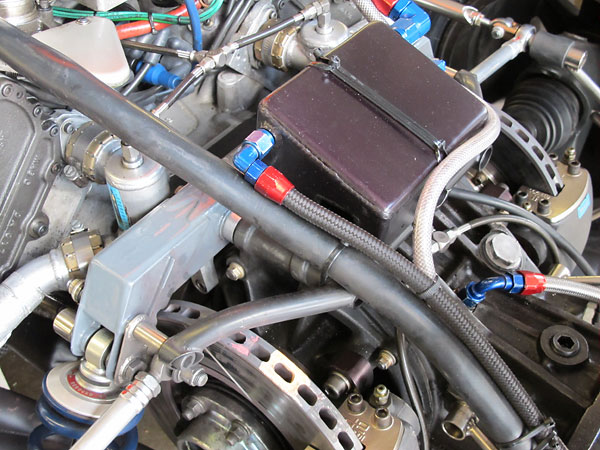
�
An aluminum catch tank was fabricated to match old photos of later year catch tanks.
�
During the 1974 season, catch tanks weren't required. A combination of heat and
�
age have turned its anodized surface from jet black to a deep purple color.
�
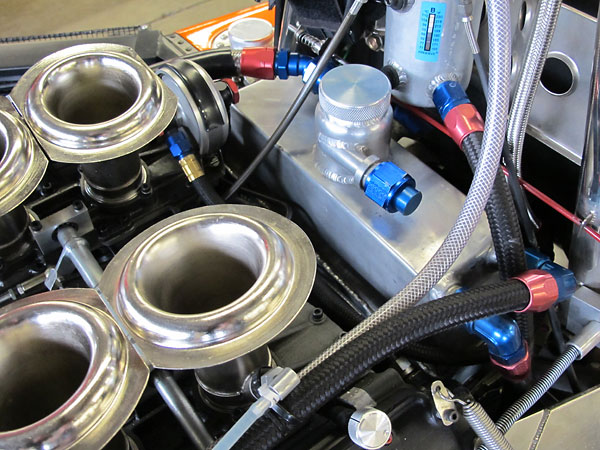
�
The is the original March engine oil reservoir with built-in swirl pot. (It's actually
�
larger and more elaborately shaped than you might think from this photo.)
�
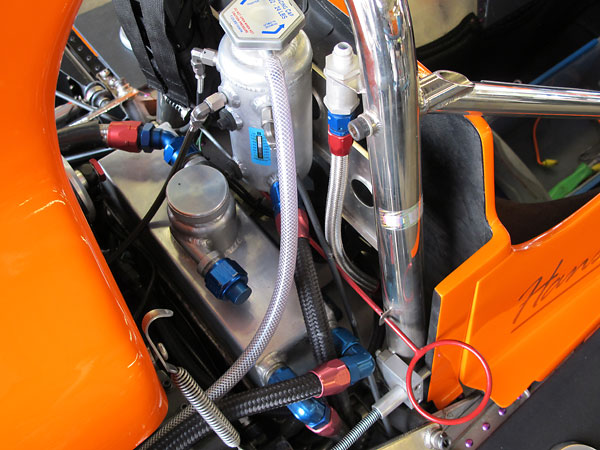
�
This large red pull-ring mechanically engages two ordinary toggle switches. Per article 298(b):
�
"Provision for a clearly indicated external emergency handle which can be actuated easily by
�
the circuit rescue personnel even at a distance with a hook. This emergency handle shall
�
simultaneously initiate the fire extinguisher, cut off the engine and isolate the battery..."
�
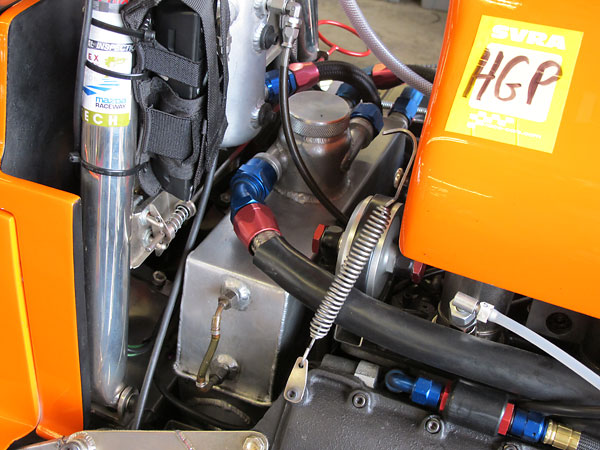
�
Left: the two toggle switches (see above). Note: the clear tubing on the oil tank
�
at right is used to gauge volume in the integral catch reservoir.
�
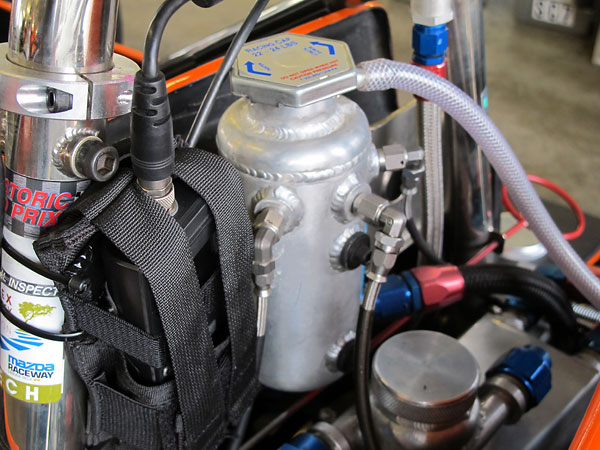
�
Coolant header tank.
�
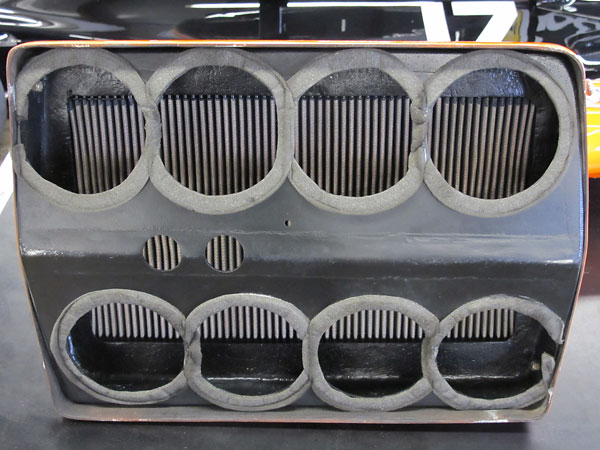
�
The large, rectangular K&N oiled gauze air filter is a modern addition.
�
Note also the two small holes through which excess air blows down onto the
�
Lucas Capacitor Discharge Ignition box when the airbox is pressurized.
�
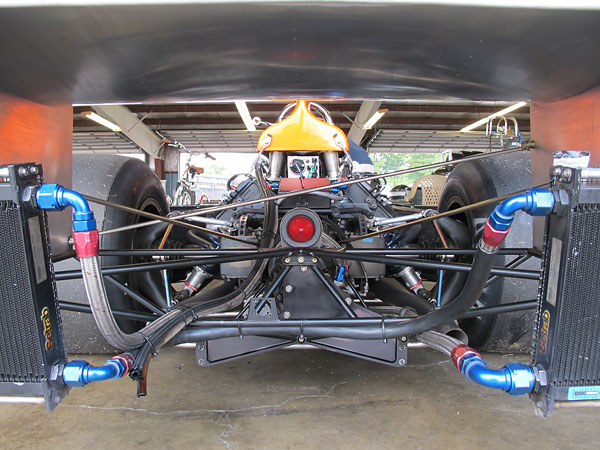
�
Authentic hose routings.
�
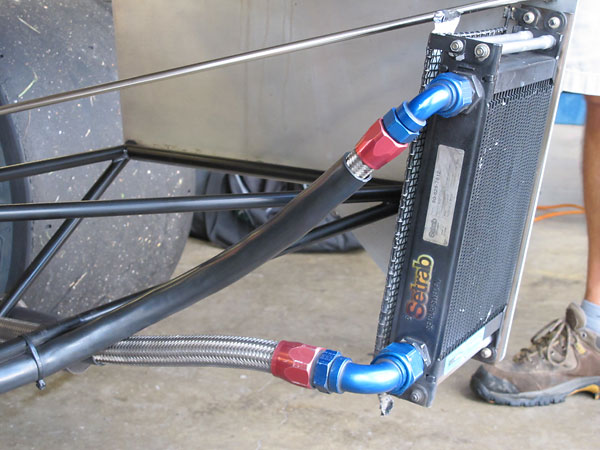
�
One of the two Setrab 50-625-7612 25-row aluminum oil coolers.
�
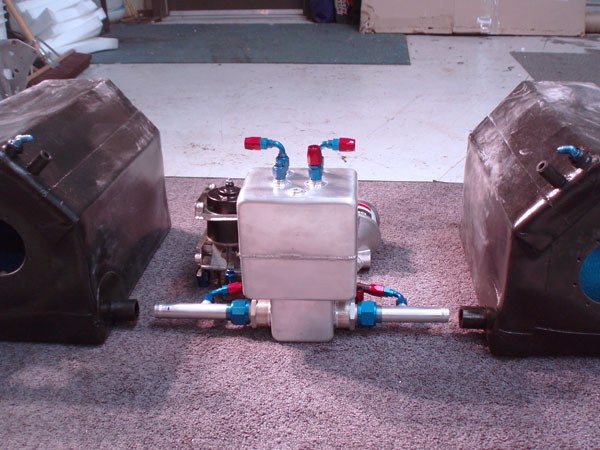
�
The 741's sidepods served two functions: they house dual fuel cells (~22 gallons each)
�
and they provide side-impact protection to the extent required by 1974 era FIA rules.
�
(Photo by Steve Cook. Used here by exclusive permission.)
�
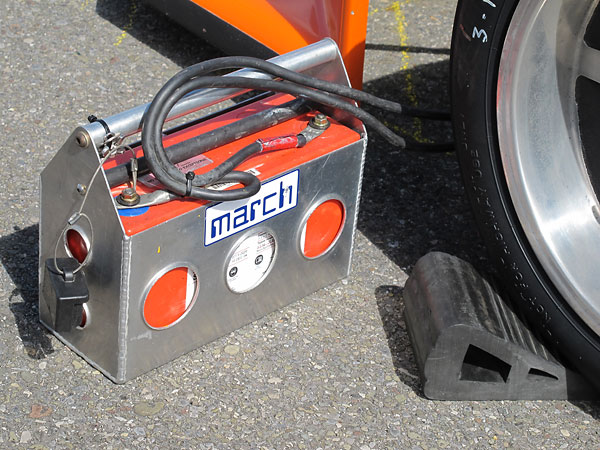
�
Jump start battery. Incidentally, the F1 cars of this era all had electric starters. Air
�
starters came along later, when constructors were making room for ground effects tunnels.
�
�
Front Suspension
��
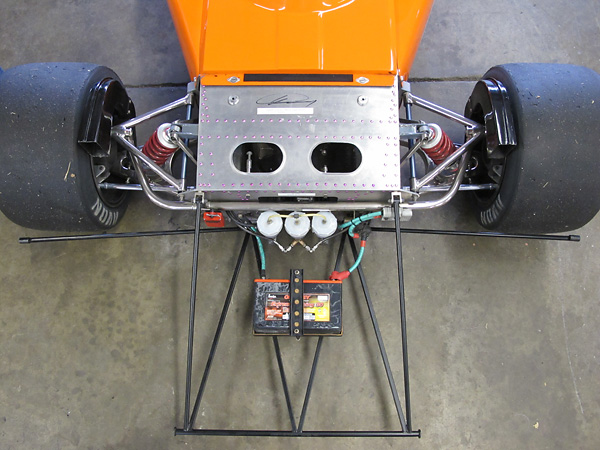
�
The March 741 front suspension shares basic layout and key components including
�
cast magnesium uprights with March's Formula Two racecars of its era.
�
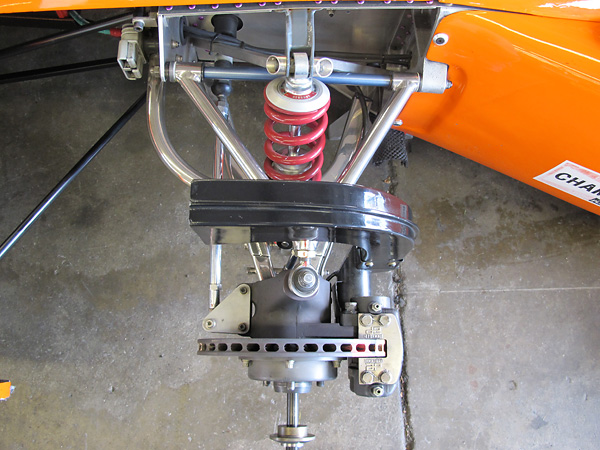
�
At right, one of the monocoque tub's three sandcast aluminum bulkheads. Two small mirror-image
�
bulkheads are here at the front, and there's one very large and elaborate bulkhead at the rear.
�
None of these bulkheads were replaced when the tub was re-skinned by Marc Bahner Engineering.
�
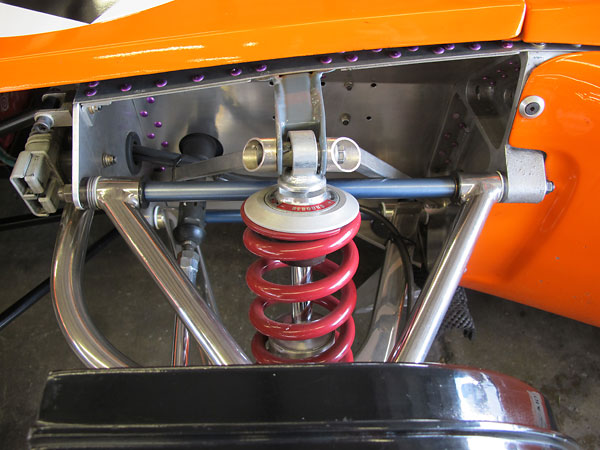
�
These square section braces for the front shock absorber mounts are believed to have originated
�
during 741-1's hillclimb carrier. They've recently been replaced with correct round-tube versions.
�
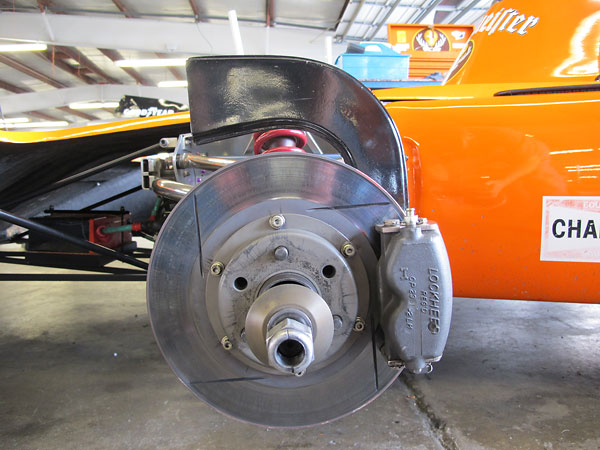
�
Outboard-mounted brakes simplify service at the expense of unsprung weight. With increased
�
unsprung weight, racers typically have to set-up the suspension stiffer than they'd prefer.
�
Some of the heat generated at the brakes transfers through the wheels and into the tires.
�
During the season March and some of their rivals suffered from excessive front tire
�
degradation and blistering. Outboard brakes may have been a contributing factor.
�
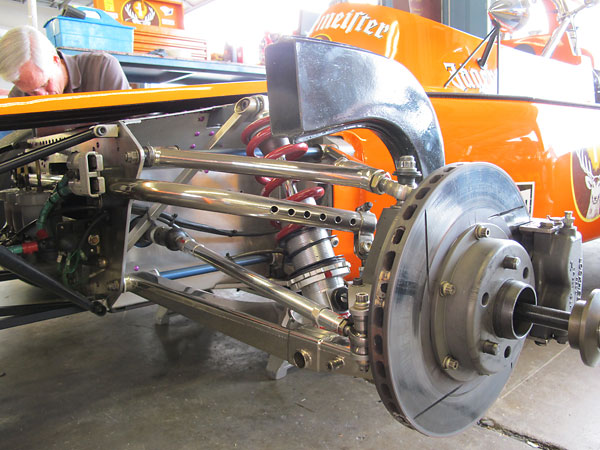
�
Per March's original engineering drawings, 741-1's new control arms and other suspension
�
components were mainly fabricated from Chrome Moly alloy steel and then nickel plated.
�
Lower front control arms were especially difficult and time consuming to make.
�
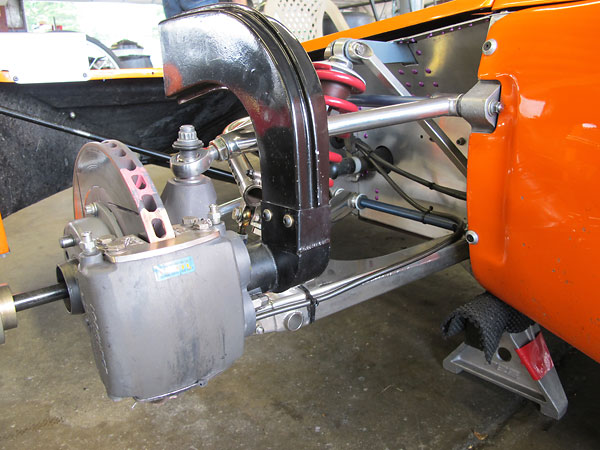
�
These front brake ducts are March's 1975-1977 style. (Since this photo was taken, they've
�
been replaced with the correct 1974 style.) They aren't particularly efficient, but they
�
certainly help. Steve built molds and then laid them up himself.
�
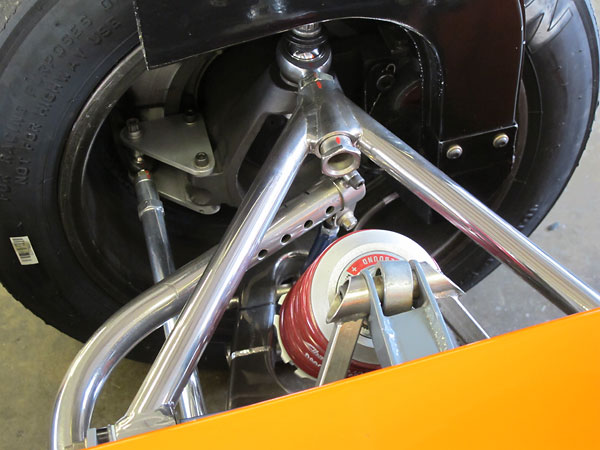
�
March 741-1 had serviceable cast magnesium front and rear uprights when Steve bought it.
�
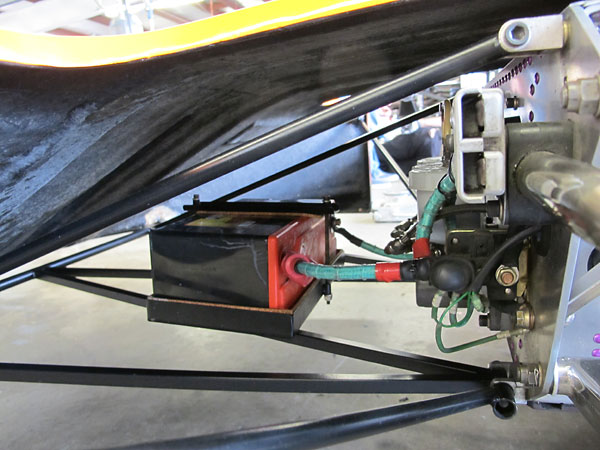
�
Odyssey Extreme Racing 30 absorbed glass mat battery.
�
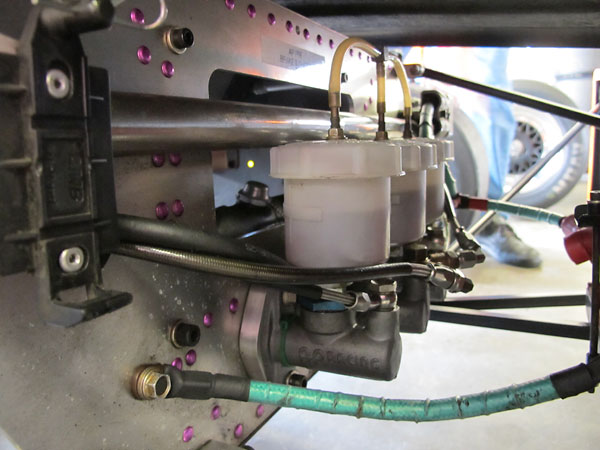
�
AP Racing master cylinders with plastic reservoirs. Label reads: "AP PRF Brake and Clutch".
�
AP PRF 600 fluid has a dry boiling point of 608 degrees. Green braided insulation on
�
battery cables and other wiring elsewhere on the car is an authentic detail.
�
�
Enjoying this article? www.BritishRaceCar.com is partially funded through generous support from readers like you!
�
To contribute to our operating budget, please click here and follow the instructions.
�
(Suggested contribution is twenty bucks per year. Feel free to give more!)�
Rear Suspension
��
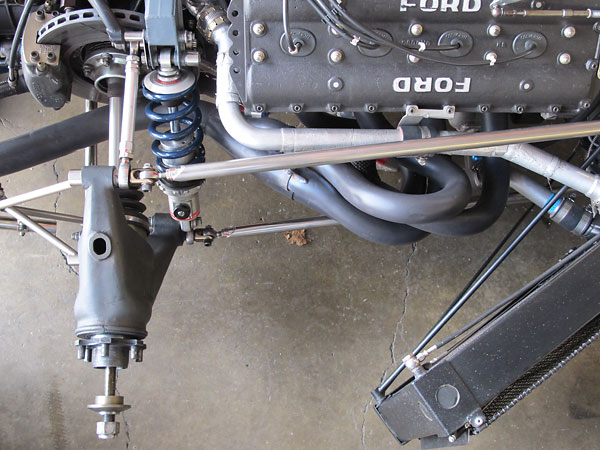
�
KONI model 8212 double adjustable shock absorbers are period correct.
�
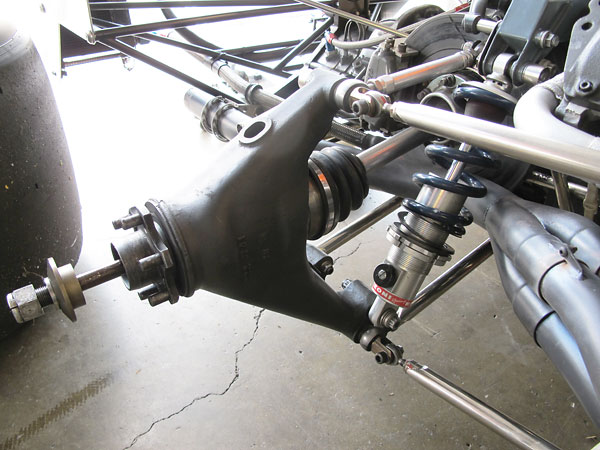
�
Steve and Doug have tried a wide variety of spring rates.
�
The suspension seems to work best with fairly soft springs.
�
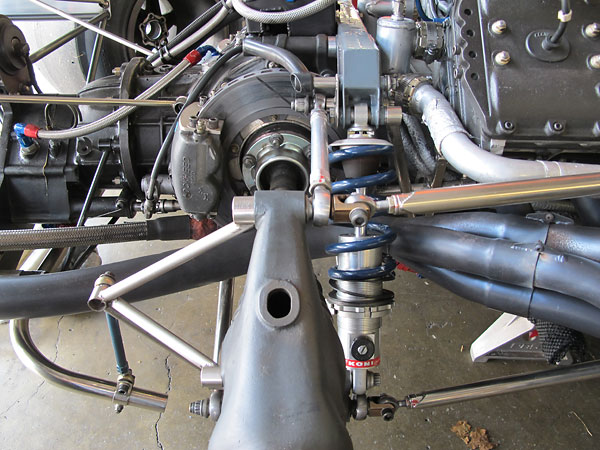
�
Helper springs help the main coils stay engaged with the spring perchs in droop. Easily
�
compressed, they have no effect on wheel rate over the suspension's working range.
�
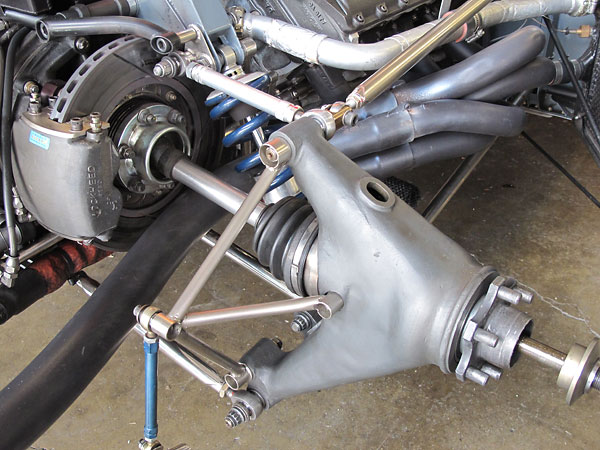
�
These exhaust headers came with the car when Steve purchased it.
�
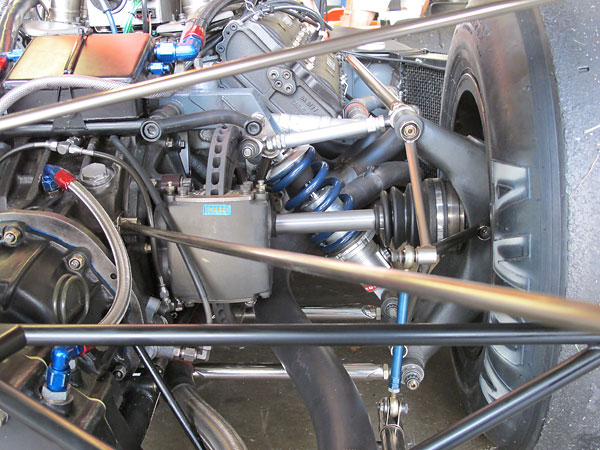
�
Generally, Steve likes to run relatively soft anti-sway bar settings for a lot of feel.
�
They have front and rear bars with various wall thicknesses, and both front and rear
�
bars are adjustable on the car too.
�
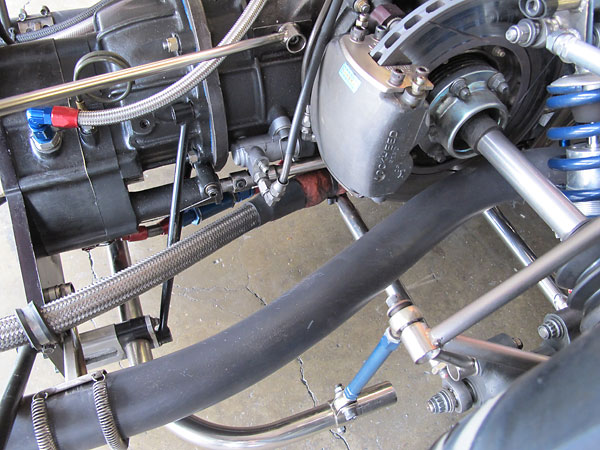
�
Lockheed CP2361 4-pot aluminum calipers and inboard-mounted vented rotors.
�
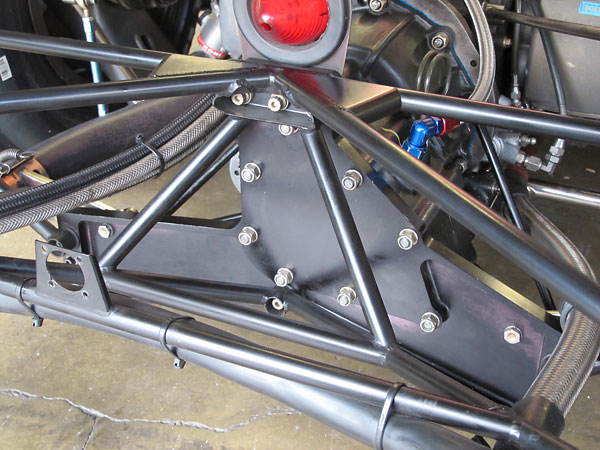
�
The rear wing mounting is based on March's original engineering drawings, but
�
with two modifications for extra safety. Where you see three bolts immediately
�
below the rain light there was originally only one. Two nickel-plated diagonal
�
support rods to the sides of the transaxle have been added.
�
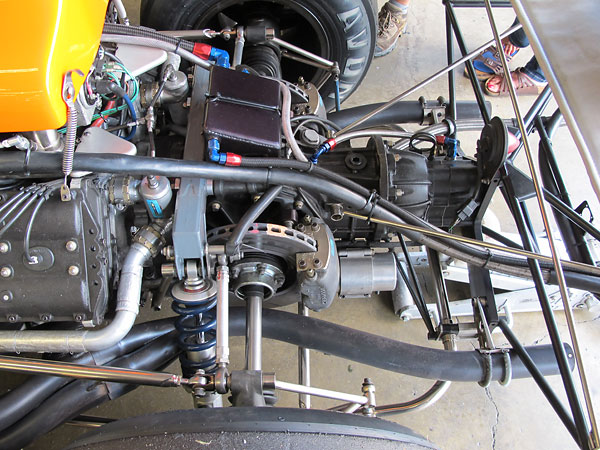
�
Notice that the brake rotors have been striped with temperature indicating paint:
�
green, orange, and red stripes turn white at ~750°F, ~1000°F, and ~1250°F respectively.
�
�
Interior
��
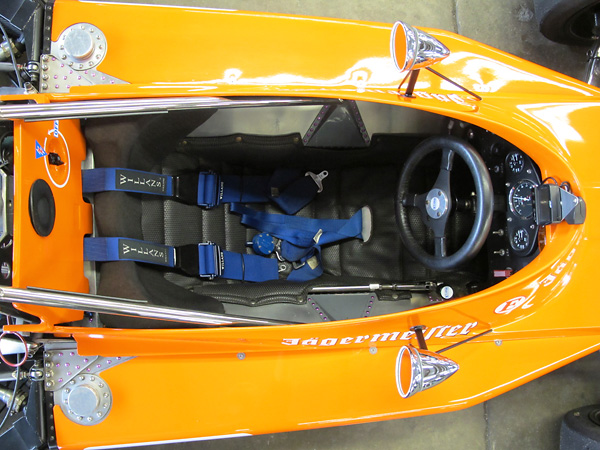
�
Willans six-point cam-lock safety harness.
�
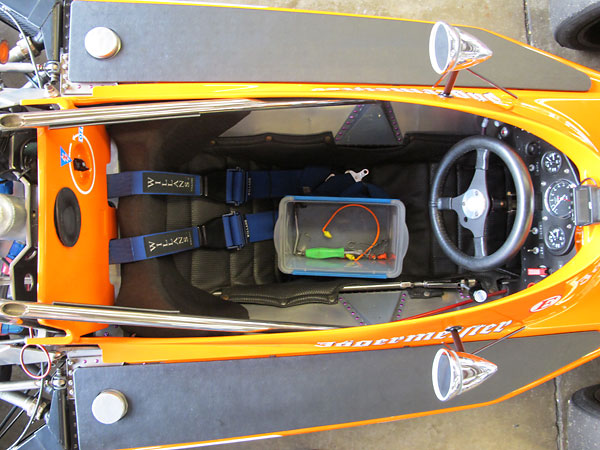
�
Foam rubber pads protect mechanic elbows and side-pod paint during routine service. Note also
�
the shallow rectangular recess in the fiberglass panel between shoulder harness straps. That's
�
where Specialised Mouldings originally put their sticker. Through the 60s and 70s, Specialised
�
Mouldings was the principal British fabricator of fiberglass racecar bodywork.
�
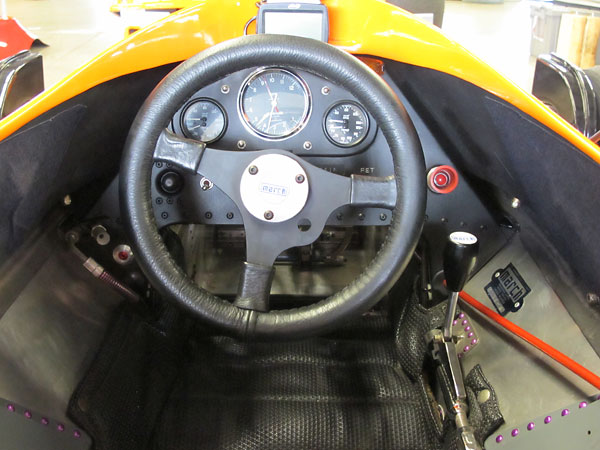
�
March 741 cockpit.
�
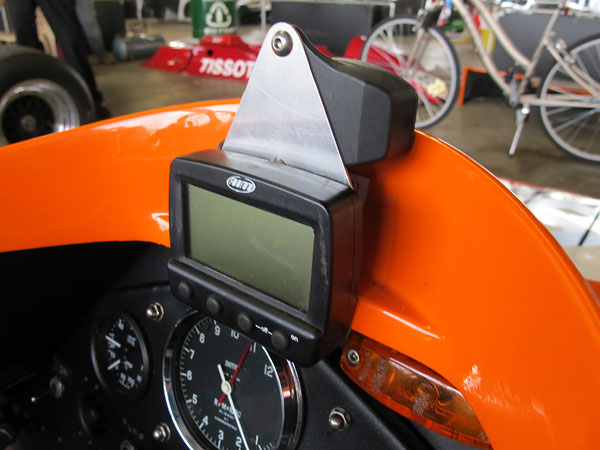
�
AiM Sports LLC's MyChron Light TG lap timer.
�
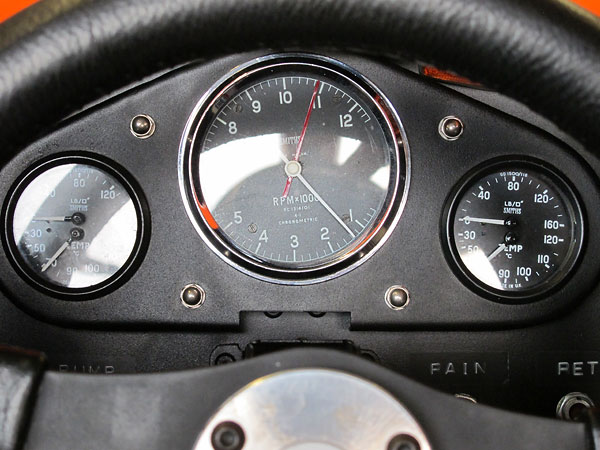
�
Smiths dual oil pressure (0-160psi) and oil temperature (30-120C) gauge, tachometer (0-12500rpm)
�
with tattletale, and dual fuel pressure (0-160psi) and water temperature (30-120C) gauge.
�
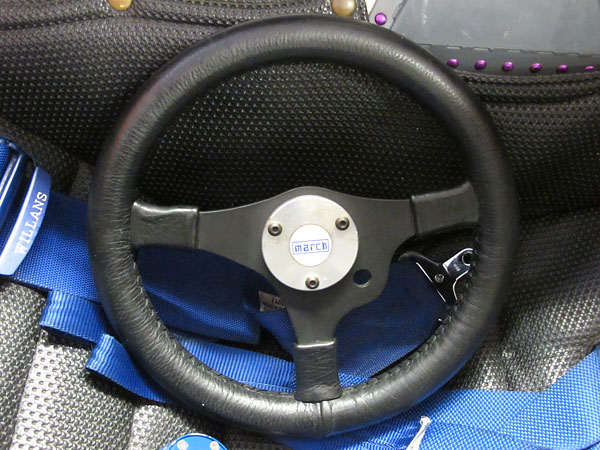
�
Steering wheel.
�
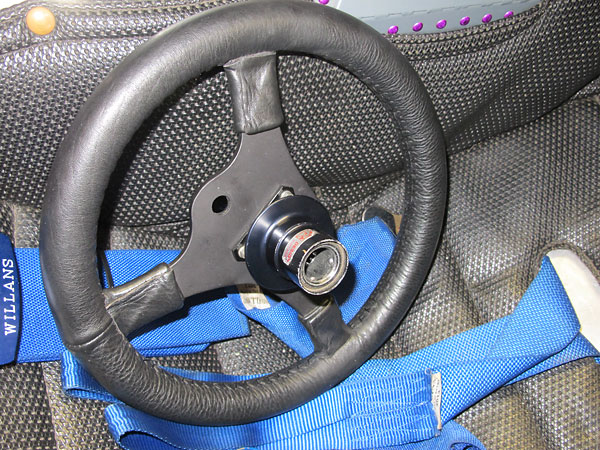
�
SPA Design quick release steering wheel hub.
�
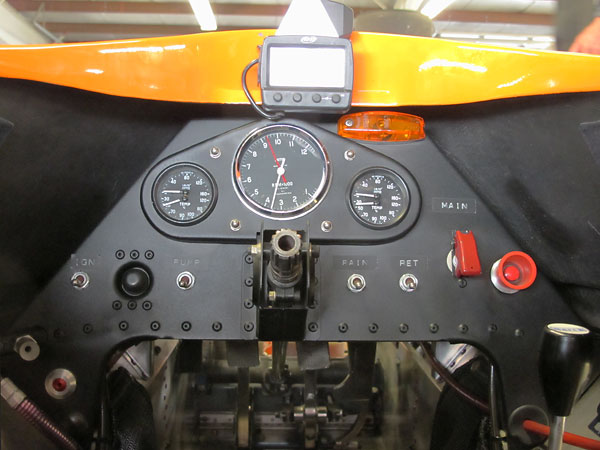
�
Dashboard switches (left to right): ignition, starter, fuel pump, rain light, retard, main, and fire.
�
The retard switch shifts ignition timing for engine start-up. (The distributor has no advance mechanism.)
�
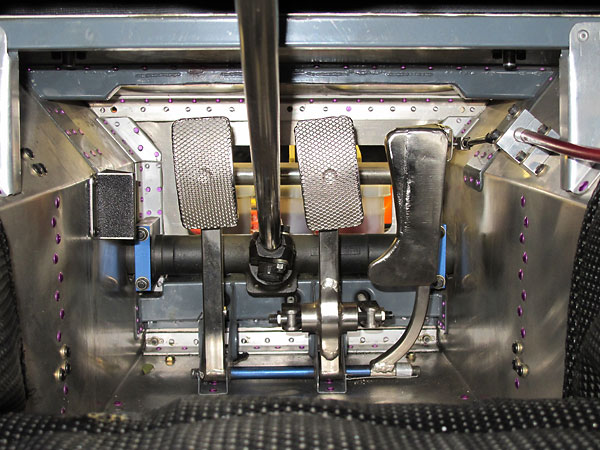
�
The pedal box and pedals are all original.
�
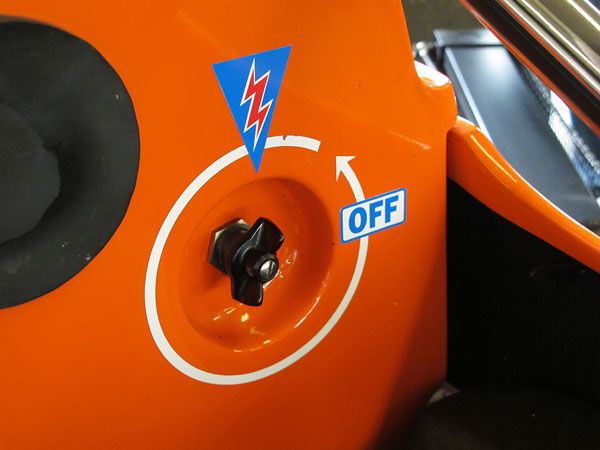
�
Per article 297(f): "...the fitting of a general electric circuit-breaker, clearly indicated, is mandatory
�
for all cars taking part in speed races. For Formula cars, the circuit-breaker must be indicated
�
by a blue triangle with a spark and be easy to reach from inside as well as from outside the car."
�
�
Exterior
��
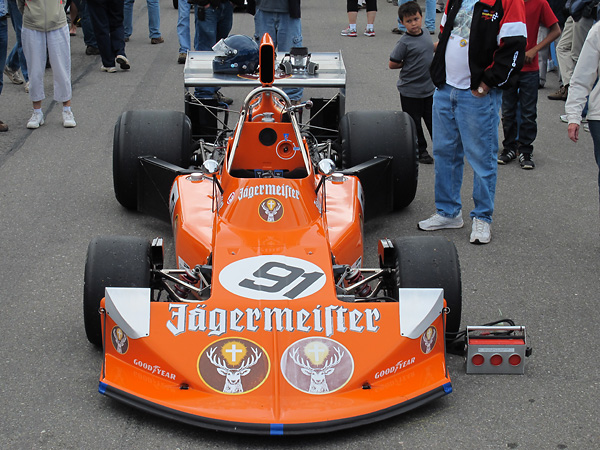
�
For the first races in 1974, March 741-1 was dark green with only small sponsor decals for
�
Goodyear, Champion, and Valvoline. Through mid-season it was dark green with orange side
�
pods and airbox. At the Swedish G.P., 741-1 wore Levi's Jeans and Västkust-Stugan logos.
�
Jägermeister livery only appeared on 741-1 for the German G.P., which was round 11 of the
�
the 15 round Championship Series schedule. After that, 741-1 was orange from stem to stern
�
with "MARCH" printed in large letters across its sports car style nose.
�
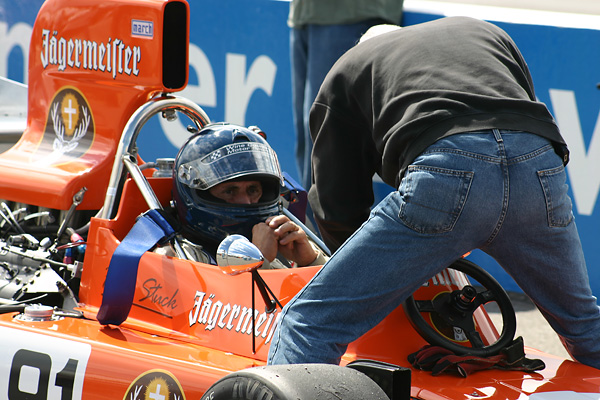
�
The shape of the side pods obscures the actual shape of the monocoque tub.
�
Without the body, in plan view, the tub looks like a big arrow head.
�
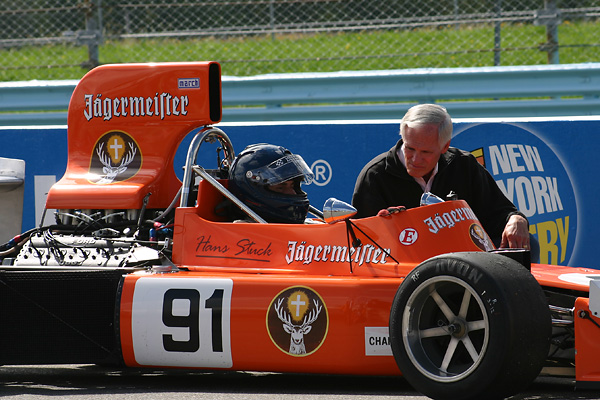
�
Steve's March 741 body panels were all made in U.S.A, but they were made to the authentic
�
shape by applying correct processes and materials (i.e. E-glass and polyester resin).
�
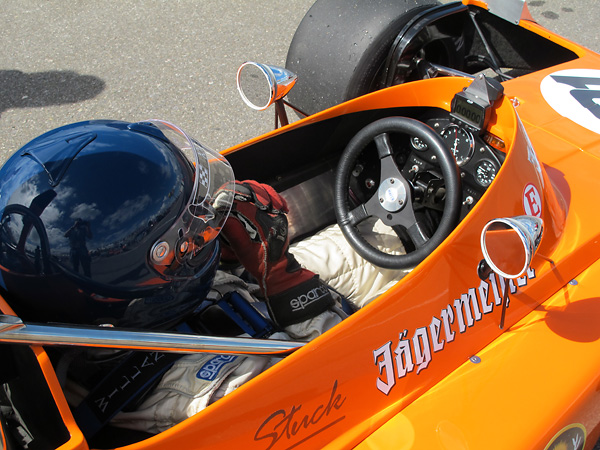
�
From 1973, Formula One rules required deformable structure to absorb side impacts.
�
Like its rivals, the March 741 used two-pack foam... For the restoration, Steve and
�
Doug substituted aluminum honeycomb panels. March installed large fuel cells
�
(~22 gallons each) on both sides. Since it's only used for sprint races now,
�
Steve installed one small fuel cell on the lefthand side.
�
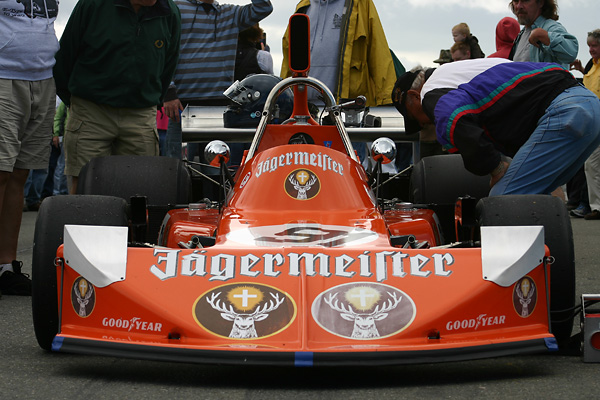
�
March sourced fiberglass bodywork from Specialised Mouldings in Huntingdon, Cambridgeshire.
�
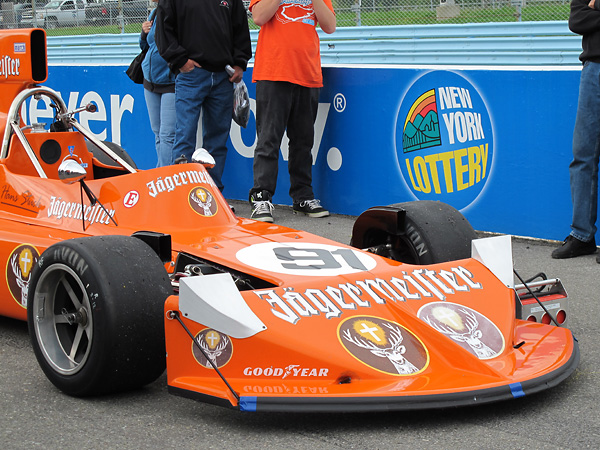
�
At their debut, March 741 racecars had a flat fiberglass panel up to the peak of the roll hoop.
�
Opening that area up fixed a big problem. Howden Ganley has commented that once excessive
�
wind buffeting was cured early on, his March 741 was a very pleasant racecar to drive.
�
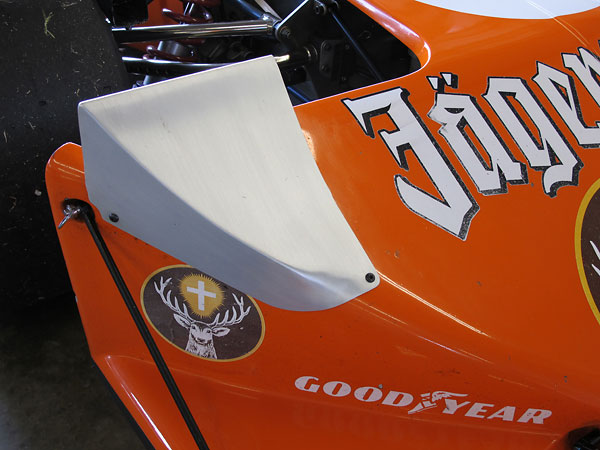
�
Fixed-height aluminum extensions on the nose act as fairings for the front tires.
�
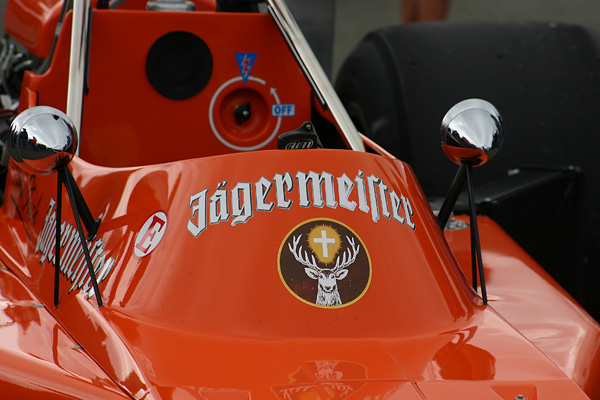
�
March originally mounted the 741's mirrors on pedestals which extended down to the
�
monocoque tub. Steve and Doug found them very inconvenient to work around while
�
servicing the car. They created these tripod mounts to the fiberglass cowl.
�
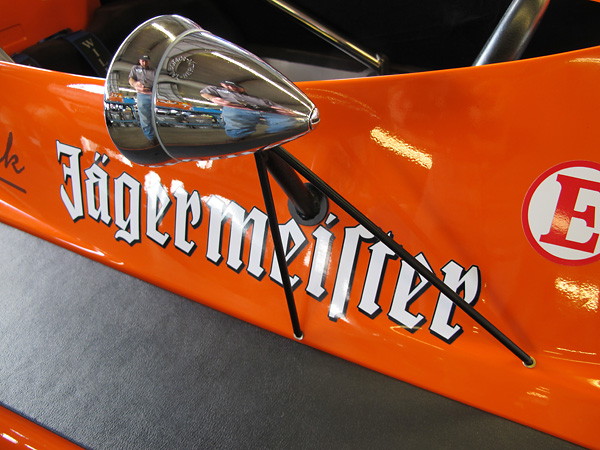
�
Talbot & Company, Berlin
�
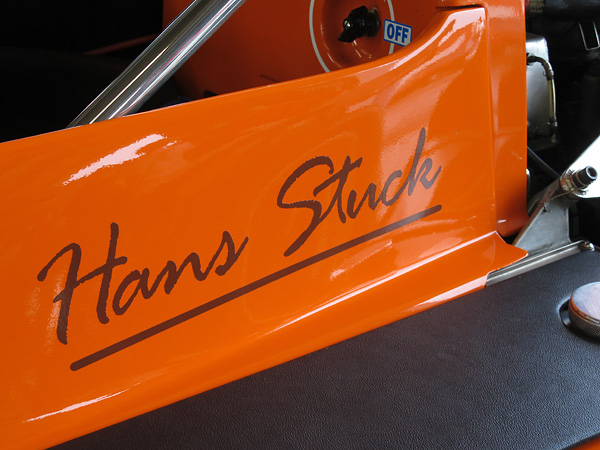
�
"Hans Stuck" - March promoted Hans-Joachim Stuck to a Formula One seat after Jean-Pierre
�
Jarier decided to move on. Hans junior (whose father won four Grand Prix races while driving
�
Auto Union racecars in the pre-war years) started his racing career in BMW 2002s. Driving
�
for the Alpina team, he won the 1971 Nürburgring 24-hour race at age 18. Stuck shared a
�
Ford Capri with Jochen Mass in the 1972 Spa 24-hours, then paired with Chris Amon in
�
1973 to contest the European Touring Car Championship and win the Nürburgring 6-hours.
�
Stuck was entered in five Formula Two races by the March-BMW team in 1973.
�
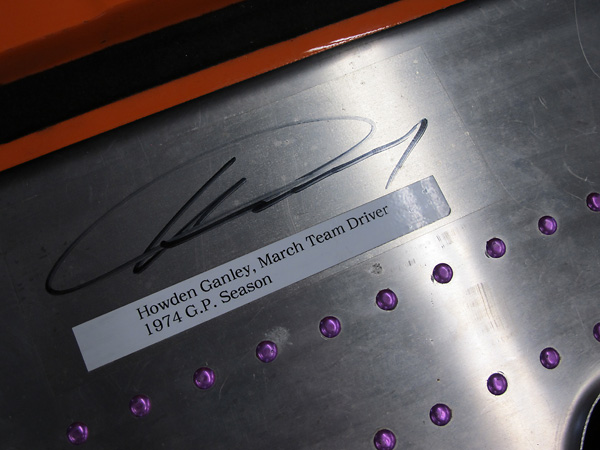
�
"Howden Ganley, March Team Driver, 1974 G.P. Season" - March was excited to recruit this veteran
�
driver for 1974, but he left after just three races due to financial reasons. Best result: 6th at the
�
non-championship G.P. of Brasilia on February 3rd. Later in 1974, Ganley drove for Japan's Maki
�
works F1 team, but was unable to qualify their car at the British G.P. and was badly injured in
�
practice for the German G.P. The ill-fated Maki Formula One car only finished one race, ever.
�
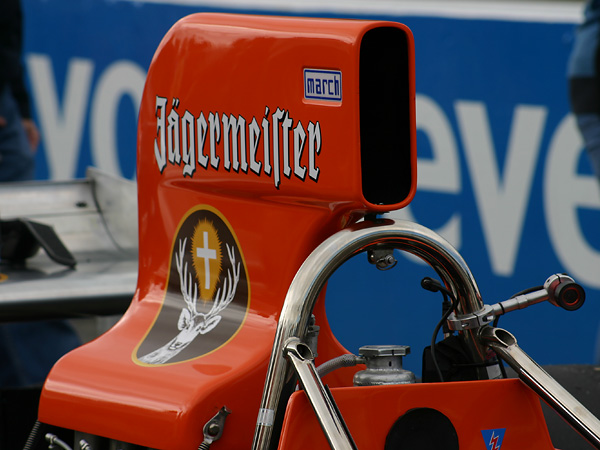
�
March used three distinct airbox designs in 1974; this is the final one. The first was
�
anvil shaped with an oval opening. The second was huge, tall, and boxy.
�
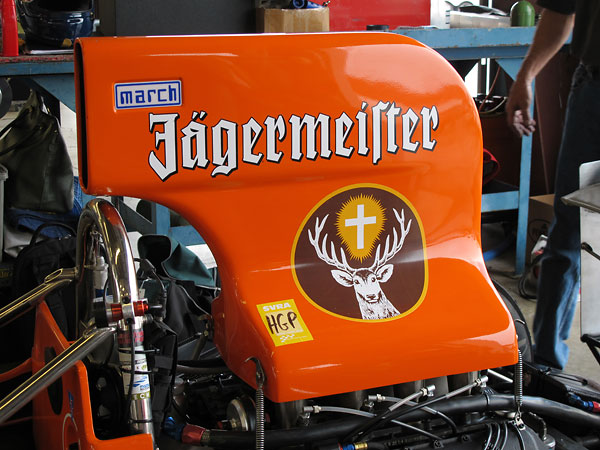
�
Jägermeister is a sweet and complex digestif with herbs, fruits, roots and spices. The recipe
�
includes anise, citrus peel, ginger, ginseng, licorice, poppy seeds, saffron, and juniper berries.
�
In German, jägermeister means "gamekeeper".
�
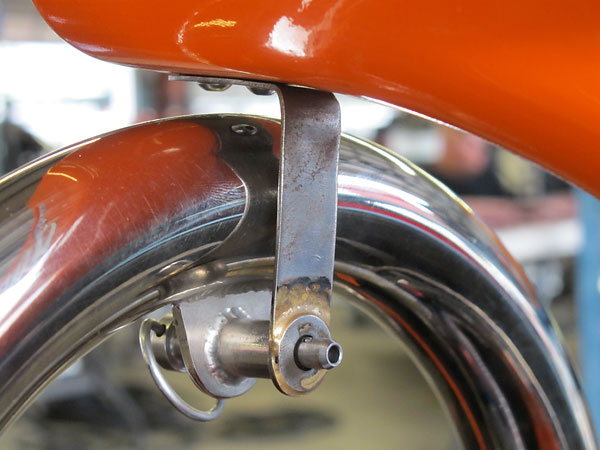
�
The airbox is held on by one pip pin at the front plus four spring-loaded clamps.
�
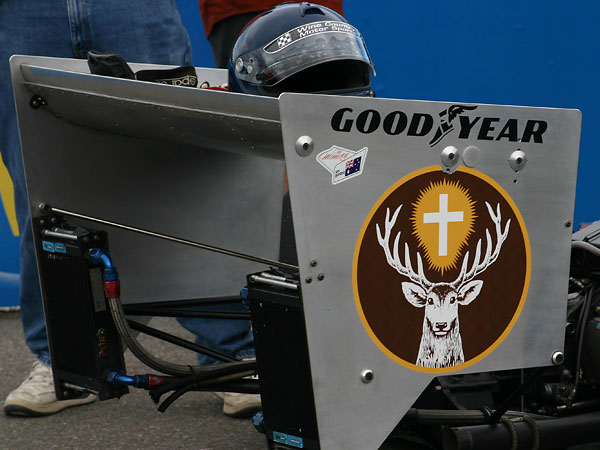
�
Sticker: "In memory Ian Gordon" with a New Zealand flag, on a rear wing motif.
�
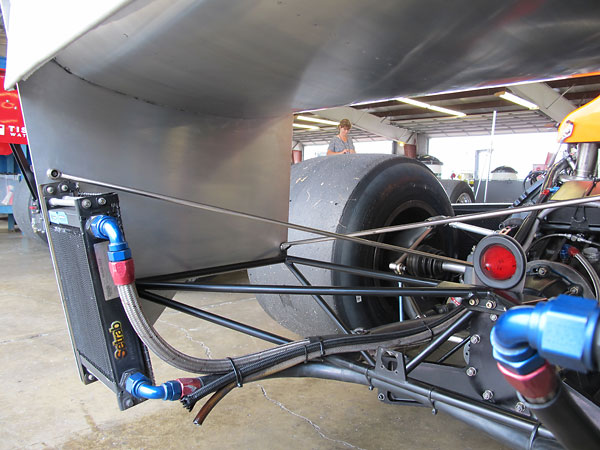
�
Two engine oil coolers are installed in the authentic positions, and fluid lines are
�
routed exactly as documented in period photos. No transaxle oil cooler is installed.
�
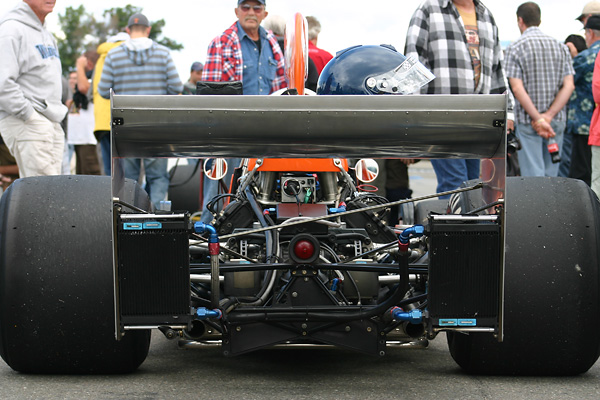
�
This wing was reproduced to original engineering drawings. Its large end plates
�
are a distinguishing features of March's 741 model. In 1975, March downsized
�
end plates and began mounting rear wings on a single central pylon.
�
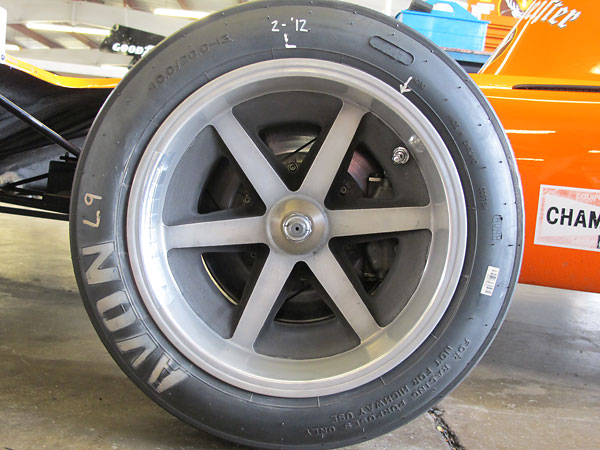
�
Steve Cook had reproduction magnesium wheels cast in U.S.A. to match March's original drawings.
�
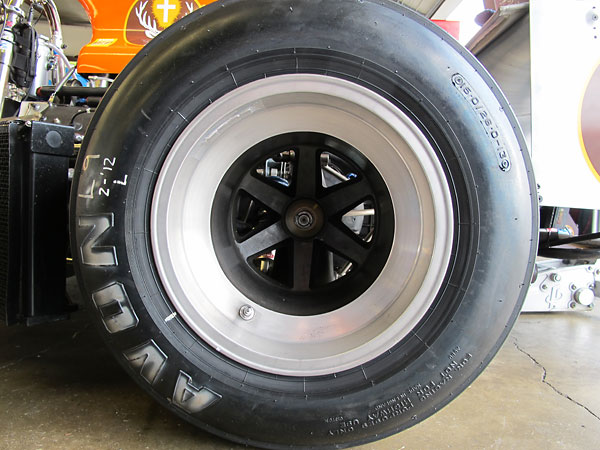
�
Firestone and Goodyear battled each other through the 1974 Formula One Championship season.
�
After Goodyear shod cars finished first in every race, Firestone dropped out of Formula One.
�
Currently, Avon Tyres Motorsport is the sole supplier to vintage "wings and slicks" classes.
�
| Notes: | ||
| (1) | �
The Hewland DG300 transaxle had been used earlier in the DFV era. It was also used for�
F5000, but the inertia of its relatively massive gears made for slow gearchanges. The DG300�
became increasingly outdated as Cosworth increased the DFV's engine RPM. Hewland's FG�
series (FG400, FGA, FGB, and FGC) were built to use smaller gears originally developed�
for the FT200 series. March specifically used FG400 transaxles in their 721, 721G, and 731�
racecars. The ill-fated 721X project initially utilized an Alfa gearbox mounted insides a bespoke�
housing, but even the 721X ended up with an FG400 for its last race, the 1972 Oulton�
Park Gold Cup.�
� | |
| (2) | �
At Monaco, Hans-Joachim Stuck crashed 741-1 heavily after an incident with James Hunt. A replacement�
tub was required. Reine Wisell drove the retubbed 741-1 in Sweden, while Stuck was away�
at Hockenheim in Germany contesting the fifth round of the Formula Two Championship season.�
(Stuck qualified fastest and finished fourth. Ultimately, he would finish 2nd in F2 championship�
points.) Stuck failed to qualify in the French Grand Prix, where his teammate Vittorio�
Brambilla qualified 16th and then wrecked chassis 741-2 in practice, so Brambilla borrowed 741-1 for�
the main event. Stuck had another ugly accident at Brands Hatch, so 741-1 needed to be rebuilt on�
a new tub. Here's the beauty part: this third tub for 741-1 was 741-2's second tub,�
straightened after being damaged in Brambilla's most recent accident!�
� | |
�
| �
� 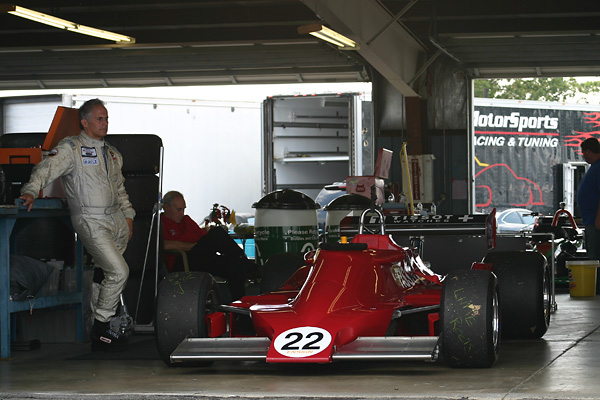 � (Bud Moeller's Ensign N177, as photographed by Curtis Jacobson for BritishRacecar.com) � Did you enjoy this article? We currently have eighty more in process, featuring about 6000 new photos. � But it takes a lot of time and expense to turn photos into articles, and to publish them on the internet. � Please consider making a contribution. Your donation will help us publish more and better articles! � � |
�
�
Except for three photos explicitly credited to Steve Cook in their captions above, �
the photos in this article are all from September 2012 when we viewed March 741-1 at�
The United States Vintage Grand Prix at Watkins Glen International in New York.�
Photos by Curtis Jacobson and Don Moyer for BritishRaceCar.com, copyright 2013. All rights reserved.
�
| If you liked this article, you'll probably also enjoy these: | �|||||
 | �
John Dimmer '72 Tyrrell 004 | �
 | �
Phil Mauger '73 McLaren M23 | �
 | �
Justin Frick '82 March 822 | �
| You're invited to discuss anything you've seen here on The British Racecar Motorsports Forum! | �|||||
�
Notice: all the articles and almost all the photos on BritishRacecar.com are by Curtis Jacobson.
�
(Photos that aren't by Curtis are explicitly credited.) Reproduction without prior written permission is prohibited.
�
Contact us to purchase images or reproduction permission. Higher resolution images are optionally available.
�

 �
�